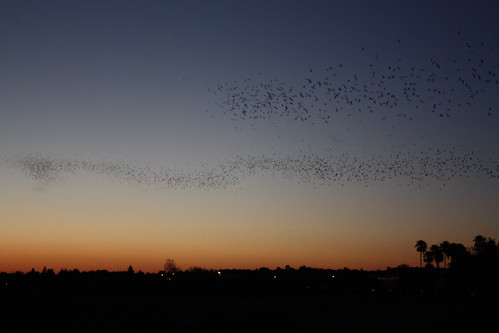Living With Urban Wildlife
By Kimberly Creagan
Tucson Green Times – July 2010
It’s that time of the year again when the hot summer weather starts to make us all act a little batty. Well, we aren’t the only ones! Tiny winged mammals in the form of, you guessed it, bats, are quite active this time of year. And lucky for us, there are many of these little guys right in town.
Before you go asking yourself, “Did she really just say lucky?” let me explain.
Those bats have gotten a bat rap. They aren’t the blood thirsty disease carriers that folklore so often leads us to believe. The risk of contracting rabies from a bat is actually quite rare; you are more likely to be struck by lightning. In actuality, these little furry guys are amazing creatures that do a lot for us and the Sonoran Desert we call home!
Bats are very important to our desert ecosystem because many are vigorous pollinators (the main source of pollination for the Saguaro cacti) and also help to disperse seeds. Those that aren’t busy pollinating are working hard to keep our insect pests under control. You can thank these furry fellows for reducing the number of mosquitoes (the true blood-suckers) that bite you this summer. The insectivore bats also help to reduce the population of insects that damage crops.
Impressively, bats have been occupying this Earth in nearly the same form for about 50 million years and occupy every continent except for Antarctica. One in four mammals on our planet is a bat. Bats are unique in the mammal world because they are the only to have developed true flight.
Sadly, bats are also one of the most
threatened land mammals in North America, with roughly half of the 45 species listed as threatened or endangered. Habitat loss and pesticide use are among the main threats to these important animals.
Also, public misconception about the danger of these animals often means removal of bats from areas where they have set up residence. Because they live in large groups and most bat mothers give birth to only one pup per year –one act of vandalism can destroy thousands of bats.
If you have a hummingbird feeder you may have already been fortunate enough to catch a glimpse of the two nectar feeding bat species that reside in Tucson. The Lesser Long-nosed bat and the Mexican Long-tongued bat both have long tongues perfect for sipping nectar from tight places. Typically, these species live in mines and caves, but will journey out at night to find food. When they aren’t drinking from Saguaros and Agaves, they may be draining your hummingbird feeder in a feasting frenzy. Typically, you will see them in the late summer and early fall.
Luckily in Tucson we still have many opportunities for viewing bats and summer
is one of the best times
to see them here.
The Mexican Free-tailed bats, which live in colonies of great numbers, are migratory and live in Tucson spring through fall. One large colony lives under the Campbell Ave. bridge at the Rillito River. You can watch thousands of bats take flight around sunset every night as they chase their insect dinner off into the sky. It’s a pretty incredible sight!
Of course, with any wildlife, it’s important to keep your distance for the health of the animal and yourself. If you see a bat crawling on the ground or acting strange, do not touch it as it could be a sign that it is sick. Watch them from a distance, listen to their unique squeaks of echolocation, and be amazed by their incredible ability to maneuver in the dark as they take ownership of the night skies.







